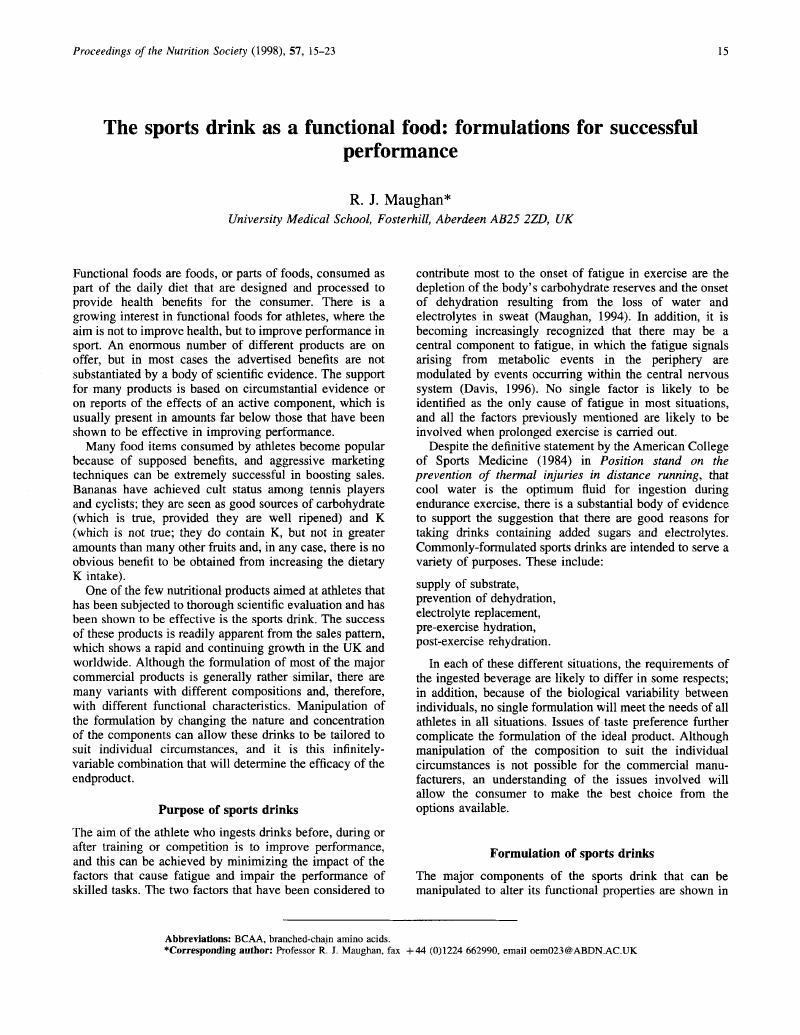Crossref Citations
This article has been cited by the following publications. This list is generated based on data provided by Crossref.
Williams, Clyde
1998.
Dietary macro- and micronutrient requirements of endurance athletes.
Proceedings of the Nutrition Society,
Vol. 57,
Issue. 1,
p.
1.
Ishihara, Kengo
Oyaizu, Shinichi
Onuki, Koichiro
Lim, Kiwon
and
Fushiki, Tohru
2000.
Chronic (-)-Hydroxycitrate Administration Spares Carbohydrate Utilization and Promotes Lipid Oxidation during Exercise in Mice.
The Journal of Nutrition,
Vol. 130,
Issue. 12,
p.
2990.
Maughan, R. J.
and
Griffin, J.
2003.
Caffeine ingestion and fluid balance: a review.
Journal of Human Nutrition and Dietetics,
Vol. 16,
Issue. 6,
p.
411.
Mizunoya, Wataru
Haramizu, Satoshi
Shibakusa, Tetsuro
Okabe, Yuki
and
Fushiki, Tohru
2005.
Dietary conjugated linoleic acid increases endurance capacity and fat oxidation in mice during exercise.
Lipids,
Vol. 40,
Issue. 3,
Jeukendrup, Asker E
Jentjens, Roy L P G
and
Moseley, Luke
2005.
Nutritional Considerations in Triathlon.
Sports Medicine,
Vol. 35,
Issue. 2,
p.
163.
Tarnopolsky, Mark A.
Gibala, Martin
Jeukendrup, Asker E.
and
Phillips, Stuart M.
2005.
Nutritional needs of elite endurance athletes. Part I: Carbohydrate and fluid requirements.
European Journal of Sport Science,
Vol. 5,
Issue. 1,
p.
3.
Strock, Gregory A.
Cottrell, Erika R.
and
Lohman, James M.
2006.
Triathlon.
Physical Medicine and Rehabilitation Clinics of North America,
Vol. 17,
Issue. 3,
p.
553.
Deldicque, Louise
and
Francaux, Marc
2008.
Functional food for exercise performance: fact or foe?.
Current Opinion in Clinical Nutrition and Metabolic Care,
Vol. 11,
Issue. 6,
p.
774.
Miccheli, Alfredo
Marini, Federico
Capuani, Giorgio
Miccheli, Alberta Tomassini
Delfini, Maurizio
Di Cocco, Maria Enrica
Puccetti, Caterina
Paci, Maurizio
Rizzo, Marta
and
Spataro, Antonio
2009.
The Influence of a Sports Drink on the Postexercise Metabolism of Elite Athletes as Investigated by NMR-Based Metabolomics.
Journal of the American College of Nutrition,
Vol. 28,
Issue. 5,
p.
553.
2010.
Bioactive Peptides.
p.
21.
Jeukendrup, Asker E.
2011.
Nutrition for endurance sports: Marathon, triathlon, and road cycling.
Journal of Sports Sciences,
Vol. 29,
Issue. sup1,
p.
S91.
Flora, Stephen Ray
2011.
Behavioral Sport Psychology.
p.
211.
Lee, Jason K. W.
Nio, Amanda Q. X.
Ang, Wee Hon
Law, Lydia Y. L.
and
Lim, Chin Leong
2011.
Effects of ingesting a sports drink during exercise and recovery on subsequent endurance capacity.
European Journal of Sport Science,
Vol. 11,
Issue. 2,
p.
77.
Ranchordas, Mayur K.
2012.
Nutrition for Adventure Racing.
Sports Medicine,
Vol. 42,
Issue. 11,
p.
915.
Ranchordas, Mayur K.
2012.
Nutrition for Adventure Racing.
Sports Medicine,
Vol. 42,
Issue. 11,
p.
915.
Tarancon, Juan
and
Lachenmeier, Dirk
2015.
Determination of Osmolality in Beer to Validate Claims of Isotonicity.
Beverages,
Vol. 1,
Issue. 2,
p.
45.
Maughan, Ronald J
Watson, Phillip
Cordery, Philip AA
Walsh, Neil P
Oliver, Samuel J
Dolci, Alberto
Rodriguez-Sanchez, Nidia
and
Galloway, Stuart DR
2016.
A randomized trial to assess the potential of different beverages to affect hydration status: development of a beverage hydration index.
The American Journal of Clinical Nutrition,
Vol. 103,
Issue. 3,
p.
717.
Martinez-Garcia, Marta
Kormpa, Akrivi
and
van der Maarel, Marc J.E.C.
2017.
The glycogen of Galdieria sulphuraria as alternative to starch for the production of slowly digestible and resistant glucose polymers.
Carbohydrate Polymers,
Vol. 169,
Issue. ,
p.
75.
De Fusco, Deborah Oliveira
Madaleno, Leonardo Lucas
Del Bianchi, Vanildo Luiz
Bernardo, Aline da Silva
Assis, Rafael Roberto
and
de Almeida Teixeira, Gustavo Henrique
2019.
Development of low‐alcohol isotonic beer by interrupted fermentation.
International Journal of Food Science & Technology,
Vol. 54,
Issue. 7,
p.
2416.
Cheuvront, Samuel N.
Kenefick, Robert W.
Montain, Scott J.
and
Sawka, Michael N.
2020.
Present Knowledge in Nutrition.
p.
503.



